
|
Tourism in Algeria
A North African land of contrasts, Algeria stretches over a 2 381 741 Km2 area. Its 6000 Kilometer long borders run along Tunisia, Libya, Niger, Mali, Mauritania, Western Sahara and Morocco.
In North, the Mediterranean Sea extends over 1200 km of
coastline while in the South the extensive desert spreads
over nearly two million square kilometers.
After having been neglected during many years, Algeria destination has experienced a renewed interest. This evolution has been marked by the appearance of new products beside the traditional stays of discovery and relaxation, while the Algerian government is setting up a strategy of development for tourism by the year 2015. Algeria has many assets. On the geographical level, four great types of relief following each other from the north to the south of the territory. Alongside the Mediterranean sea, there is a coast bordered by beaches and coves, prolonged inside by the plain of Tell and its valleys where is concentrated the main part of the arable lands and the principal major cities like Algiers, Oran, and Constantine... there are two East-West directed mountainous chains: the Tellian Atlas formed by the mounts of Tlemcen, Ouarsenis, Titteri, Djurdjura, Babor, Bibans and Edough which culminates in Lalla Khadidja (2, 308m), and the Saharian Atlas with the solid mass of Aurès culminating with the mount of Chelia (2, 328m). In the middle of the Atlas, a zone of semi-desert high plateaus, field of the esparto grass and of breeding and whose profile of a basin explains the presence of shotts (salted lakes) up to 40 meters below sea level, the shott Melhrir. 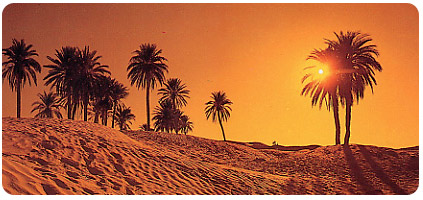
There is also the Sahara, its rock plateaus, its arid
plains, its sand areas, the great Western erg, the great
Eastern erg and its oases like Zibans, the valley of M’Zab,
Touat, and Gourara... Finally in the extreme south, Hoggar,
there is a succession of high plateaus spread out in steps,
dominated in the centre by surprising relief and the Tahat
mount, with 3 003 m which remains the highest summit of the
country, and where there are some salted lakes like shott
Ech-Chergui and shott el Hodna... To these natural charms is
added an archaeological inheritance of a great value.
Crossroads of the Mediterranean, Moslem and African worlds, Algeria inherited a number of numidian and Romans sites, (in the east of Mauritania, in Aurès and in the north of Numidia), as well as Christian and Islamic sites and buildings. 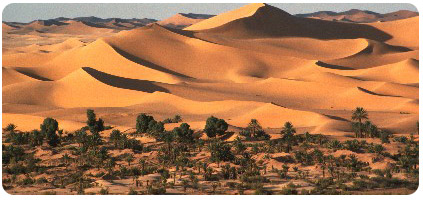
Various activities can be practiced during all the year in
focal points where exoticism and beauty go hand in hand:
• The coastal strip • The Aurès Mountains • The Kabylie region • The Wadi Me Zab valley • Oued Souf • The Hoggar Mountains and Tassili • Touat and Gourara 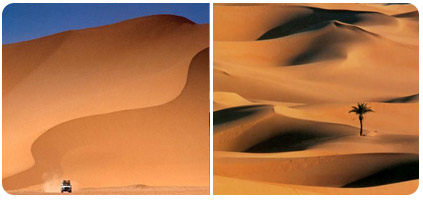 A country of virgin sites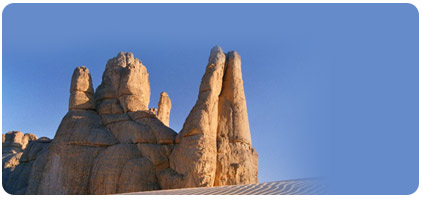
According to forecasts of the ministry of tourism, by the
year 2015, tourist flow will pass to 3.1 million visitors
against 1.6 million in 2004 and the cumulated payments of
the tourist activity would be in 2015 of more than 6 billion
dollars. Currently, 22 ZET are subject to a development
study held by the National Agency of Tourist Development (ANDT).
Nineteen of the ZET retained for study are located on the
littoral extending over more than 1,200 km and the three
others are in Tamanrasset, Djanet and Timimoun. However, the
22 concerned ZET totalize a surface of development
equivalent to 1443.83 hectares. These sites are part of the
projects of realization of 144 hotels, 550 villas, 3000
bungalows, 8 marinas and pleasure ports, 4 spas, 15 shopping
centres and 4 sports centres. These tourist achievements
must generate a capacity of lodging of 50,000 beds. However
the ZET of Djanet and Tamanrasset have the priority and must
be subject to a special consideration since they are a
privileged destination by foreign tourists and also because
of the sensitivity of their ecosystem. For that reason, a
sustainable strategy for the development of tourism in
Algeria by 2015 has been planned , with several incentives.
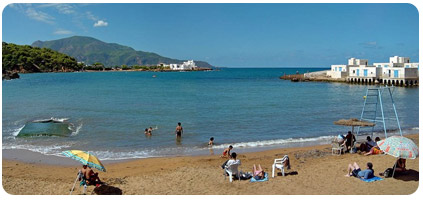 This strategy is particularly based on the definition of the choice of the tourist offers to be developed, the determination of the objectives to be reached as well as the determination of the socio-economic impacts. Concerning the development and the control of tourism real estate, the development of a program and the launching of a study for the delimitation and the declaration of the zones of tourist expansion are expected. It is also expected to achieve, by 2007 a study relating to the thermal assessment, which potential is evaluated to more than 200 thermal sources, and to the transfer of the lands in the chosen ZET to the ANDT. The objective is to develop these lands and to put them at the disposal of the investors, as well as providing consequent financial means to the Fund for Support to the Tourist Investment. It is also expected, by 2015, to realize 187,000 beds, that is to say 55,000 beds in 2007 and 60,000 beds in 2015 with 23,000 direct and indirect employment.
However, this objective needs some incentives to the tourist
investment, like an adequate adaptation to the tourist mode
of financing which remains a heavy investment. It is also
expected the creation of a mode of financing specific to the
hotel credits which must profit from reduced interest rate
and other incentives
ALGIERS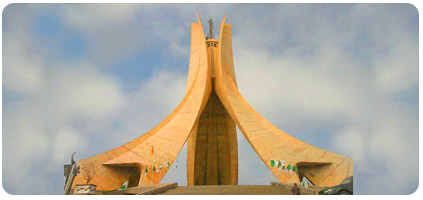
Hung to the hills of the Sahel at the end of the plain of
Mitidja, Algiers presents the traditional urban plan of a
Mediterranean city: an acropolis - the Kasbah leaned with a
massif- Bouzareah -, and a set of hills intersected with
small valleys forming a majestic bay, which extends from the
Pointe Pescade to La Pérouse. Even if the Moorish palaces
have for many disappeared, Algiers the White remains one of
the most beautiful cities of the Arab world. It is while
strolling around the twisting roads, the staircase-like
backstreets, the monuments and the modern district that one
can discover this metropolis which summarizes the whole
Algeria of today, a country rooted in his traditions and
passionate of modernity.
The
Casbah
Overhanging the small islands, the médina remains Algiers bearing the prints of the Orientalists of XVIe, XVlle and XVllle centuries and if the ramparts disappeared, the impression is remaining. Half of the houses is of Ottoman inspiration: corbelled floors supported by apparent wood props, interior patio decorated with ceramics and small columns. Place of memory as much as place of history, the Kasbah has a citadel, old mosques, Ottoman palaces, a labyrinth of souks, eternal paradise for shopping, and of small bars where it is good to stop to taste a chorba frik, ragout of mutton meat with chick-peas, followed-up with mint tea.
Palaces
El Djazair El Mahroussa had sumptuous palaces decorated with
taste and pomp. Today, although many of these buildings
worthy of Thousand and One Nights disappeared, some have
escaped to the vagaries of time and of the Man. They are
here to remind us our prestigious past. They only can be a
very privileged tourist destination.
Dar Aziza, is the prototype of the Algerian house with his court of marble and central water jet, its earthenware, its stuccos and its trellis with coloured glass, next to Jenina (headquarter of the government until 1817). It is at the palace Dar Mustapha, built by Dey Mustapha in 1797, that are noticed the front door and the canopy in sculpted cedar, two skiffas (corridors) decorated with Dutch and Italian earthenware, the columns of marble, the sculpted woodworks, the balustrades and the double doors of rooms with porticos. The Bastion 23 is the palace of the captain Raïs, built on the sea front in 1826 and inhabited by the Minister for the navy who could thus control the bay. This palace had a hammam built above the kitchen to diffuse a constant heat, a wash-house supplied with two wells, one containing the drinking water, the second collecting rainwater. This building which is open to the public is composed of three parts: the residence of Raïs where the living rooms, rooms, dining room and office are decorated with different ceramics and of sculpted woodworks. There is also the district of the servants, the small houses intended to the sailors and to the fishermen. While descending the street Hadj Omar, there is the palace of Ahmed Pasha (1805-1808). It provides a base for Algerian National Theatre, equipped with a beautiful staircase with elbows leading to the interior court.
Dar Hassan, is a Moorish palace of Hassan Dey of Algiers and
the last of the regents at the end of XVllle century. It has
been transformed into a winter palace of the French
governors and will was known as the Palais Bruce.
The Big Mosque, was built at the end of Xlst century by the Almoravides. It is a magnificent example of the Islamic architecture. There are five doors leading to the interior and a patio looks out over the old court of malékite rite and over the office of the muphti. In the prayer room, there is an admirable minbar (pulpit) dated of 1098 and some foiled arcs. The mosque of la Pêcherie, is a rather particular monument which would have been built in 1660 by the corporation of bahhâras (marines). Its minbar, made of sculpted marble, belonging to the old mosque Essayida. Some old koursis (armchairs) are also worthy of being admired. They belonged to the preachers and are made of painted wood and a very beautiful copper chandelier close to the minaret, the old court of hanéilte rite.
The Betchine mosque was built in 1622 by the Italian corsair
Picinino who became admiral of the Algerian fleet. It has a
typical architecture of the Ottoman mosques.
The old cathedral Saint Philippe, built between 1845 and 1860 and called Djamaâ Ennassara by the Inhabitants of Algiers, returned to the Moslem worship after the independence and recovered its old name “Ketchawa” (plate of goats, in Turkish). Its columns and its minbar belong to the old mosque. The frontage, flanked by two tours, is inspired from the Byzantine architecture.
At the street Arbadji, the tomb of the saint patron of the
town of Algiers: Sidi Abderrahmane. The building was built
in 1696. It is composed of a koubba where the tomb rests, of
the saint man of a mosque to the square minaret and a
cemetery reserved to the famous men such as Ahmed Bey of
Constantine and Mustapha Pasha.
Among the other historical buildings of the old médina of El
Djezair, there is Hammam Sidna, and the baths of the Dey,
which have always been working since the XVIe century. In
the east of Algiers, the turquoise coast provides a home for
beautiful rock coves and sandy beaches lined with cypress,
cork oaks and olive-trees. The peninsula of Sidi Ferruch has
a marina and offers possibilities of underwater fishing.
Oran, bordered with wine fields, is the second town of
Algeria. Activate, dynamic, it is the centre of multiple
trade and industrial activities around its port. The
influence of the Spaniards, having occupied the city during
almost three centuries, is visible through many
Hispanic-Moorish buildings. Around Oran, there are several
seaside centres composed of hotels provided with nautical
equipment....
Antique cities
Ancient cities such as Timgad, Tipaza, Djemila, Hippone and
many others appear among the most beautiful archaeological
vestiges, both by the beauty of the ruins and their
historical and scientific value.
Timgad
Released since 1880, this perched city at 100 m of altitude
had a theatre, 14 thermal baths, a capitole, a public
library equipped with a unique semicircular reading room,
a “civil basilica,” kind of law courts, a Christian
necropolis, in which some 10,000 tombs can be found, markets
with shops, and a theatre which can contain 3,500
spectators. Its triumphal arch, set up in the IInd century
in the honor of the victory of Trajan over the Parthes, is
one of the most beautiful of the Roman empire. Its temple,
set up on a platform accessible through a 38 step, had a
pediment with six columns (two have been restored). There
was also a donatist cathedral in the south-west of the city
and a large Christian monastery.
But it is in the cultural richness that the originality of Timgad lays. From the Ist to the IIIrd century, the city had its architects, its decorators and its Numid mosaists. In the IInd and IIIrd century, they created new ways, less regular taking into account the relief, as well as new districts, and the theatre, positioned on the side of hillock. The museum of Timgad shelters one of the most beautiful collections of mosaics of all Algeria. After ten years of interruption, the city joined again with its festival of popular art. “Aurés in Festival”, represents two weeks of galas, and cultural and handcraft shows. The tapestry of Aurès, very well known beyond the Algerian borders, receives the honors it deserves. Tipaza
Baptized “Pine setting”, Tipaza has the charm of the towns
of sea-side and mountain. Nested on the foot of the Chenoua
mount, top of 900 m snow-covered during winter and going
down towards a broad beach, it was occupied as from the
middle paleolithic. The Rassel cave close to Chenoua would
have been inhabited 12.000 years ago AC. Several
civilizations followed one another. Recent excavations
released the remainders of a tusk integrated into the
ramparts and a necropolis with columbarium.
In the oldest district of Tipaza, can be found the “legal
basilica”, in which the splendid mosaic of the slaves was
discovered, and that is exposed in the town museum.
Djemila Djemila was founded by the Nerva emperor in the North-East of Sétif at the edge of the Ferdjioua mounts. Half way up of a soft slope towards the confluence of two oueds (rivers) Guergour and Betane, in which the valleys take forms of torrential gorges. This city with its temples and its basilicas with 900 meters of altitude is another remarkable example of the adaptation of the diagrams of Roman town planning to the environment The Sahara, the land of peace
The plate of Tassili Ajjer, maze of cliffs and dunes in the
north of Djanet, is the most popular circuit of the great
Saharan south. Accessible in a four-wheel-drive or on a
camel’s ride, it makes it possible to discover the reliefs
and the rupestral art of the plateau, witness of the
everyday life at one time when the Sahara was timbered and
crossed with rivers.
Some sites are pure wonders, in particular Jabbaren, Tamrit
and Sefar. One can also choose to spend one week in Hoggar
on the traces of Father Charles of Foucault, founder of the
congregation of the little brothers of Jesus, who spent five
months in Assekrem. This perched refuge has 2,180 meters,
and offers a superb panorama on the Tahat mount. A
four-wheel-drive climbs easily up to the hermitage where one
can spend the night, and that can be reached after five hour
drive; then one has to use a path dug in the rock which
leads there (15 minutes of easy climbing). The moments to be
looked forward to are the sunrise and the sunset. Two
brothers of Jesus always live in Assekrem and celebrate the
mass there.
Tamanrasset, first urban crossroads while arriving from
Niger, entry gate to the Tassili of the Hoggar and the
starting point of excursions, is not any more the small
village “animated with 20 fires” as described by Charles de
Foucauld. The city, with the obsolete charm and the
apathetic atmosphere, deserves that we dwell on it. With a
population of 70,000 inhabitants, “Tam” is the
administrative capital of the area and military reserve.
The trekking from Atakor to Taessa within a wild framework
of the Hoggar of 1800 to 3000 m makes it possible to
approach the Tuareg society in its traditional life. Taessa,
granitic Massif, spread over more than 60 km, is a
privileged place for the campings of Kel Ahagar. We travel
from Atakor, central part of the Massif of the Hoggar, to
Taessa, to admire its rosy granites, its gueltas* in stages
at the bottom of gorges covered with pink laurels or
olive-trees, its cliffs overhanging from the green valleys
and varied fauna. The surrounding austerity shows why this
bastion could keep for so long the men’s legend.
Frescos of Tassili
Compared to the European rupestral art, primarily animalist
and hidden within caves hollow, the rupestral art of Tassili
is very scenic and, most of the time, on the surface. In
addition, the communications between North Africa and Europe
having been crossed since the end of the medium Palaeolithic,
this art has remained both independent and African until the
Christian era.
Oases
To understand the soul of Algeria, its oases should be seen:
Holy Cities of Ghardaia, Blessed Izguen, El Ateuf, Bou Noura
and Mélika, founded by Ibadites, puritans of Islam, in the
M’Zab country at the entry of the great south, and the oases
of the Chaambas and Gouraris tribes.
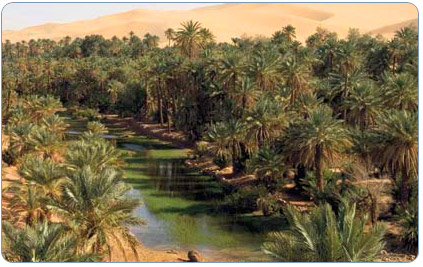 UNESCO classified sites
Timgad is a military colony
created by the III August legion in the year 100
by Emperor Trajan on the northern slopes of the
Aurès Mountain range (province of Batna);
Tipaza was a Punic counter and a strategic base for the Roman conquest of the Mauretanian kingdoms. It was listed among the 33 sites of the world’s endangered heritage by the 26th Session of the Committee of the World Heritage in Budapest on June 26, 2002; 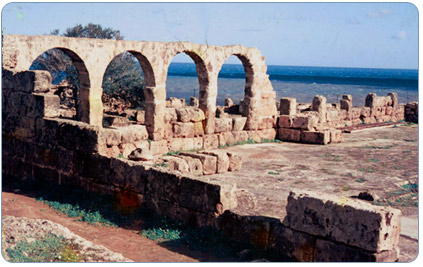
Djemila, the antique Circul, is
located at about 30 km from Sétif;
Tassili N’Ajjer (provinces of Illizi and Tamnarasset) is the vastest museum of prehistoric rock art in the world. More than 15,000 drawings and engravings tell the stories of the climates, fauna and the human life in the Sahara from 6,000 BCE to the early centuries of our era; Kalâat Béni-Hammade in Bechara (province of M’sila), is a Moslem stronghold, founded in 1007 and was the first capital of the Hammadite emirs; The M’Zab Valley (province of Ghradaïa) whose k’sours (fortified villages) preserved the habitat created in the tenth century by the Ibadites; The Casbah, the legendary Islamic medina in the capital Algiers. |